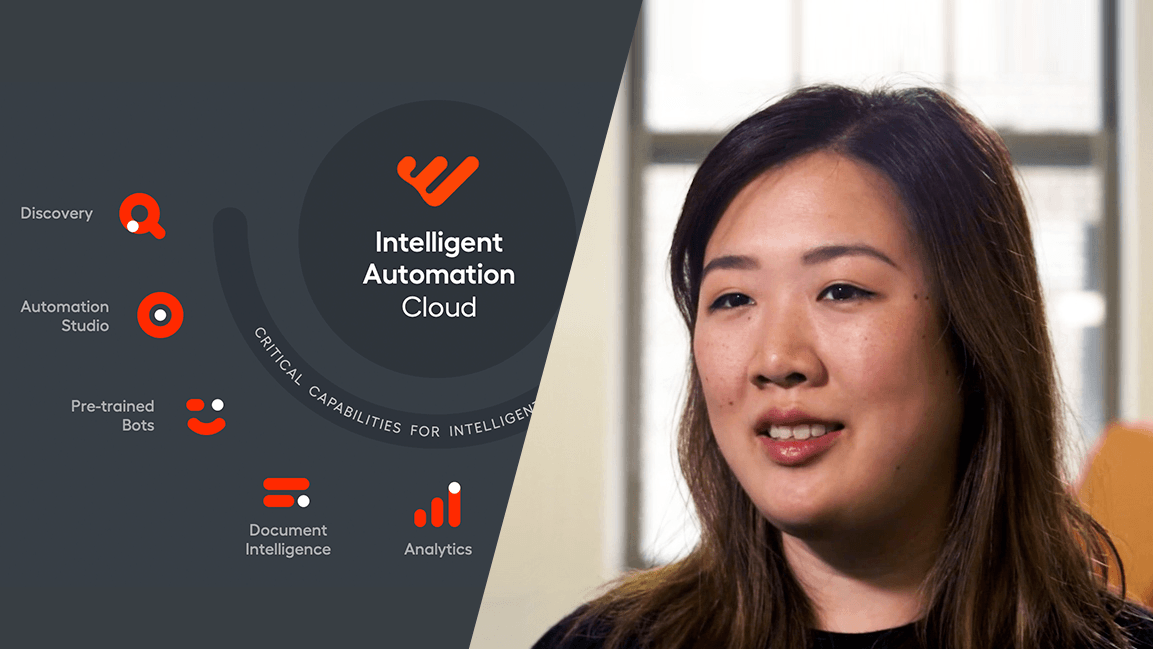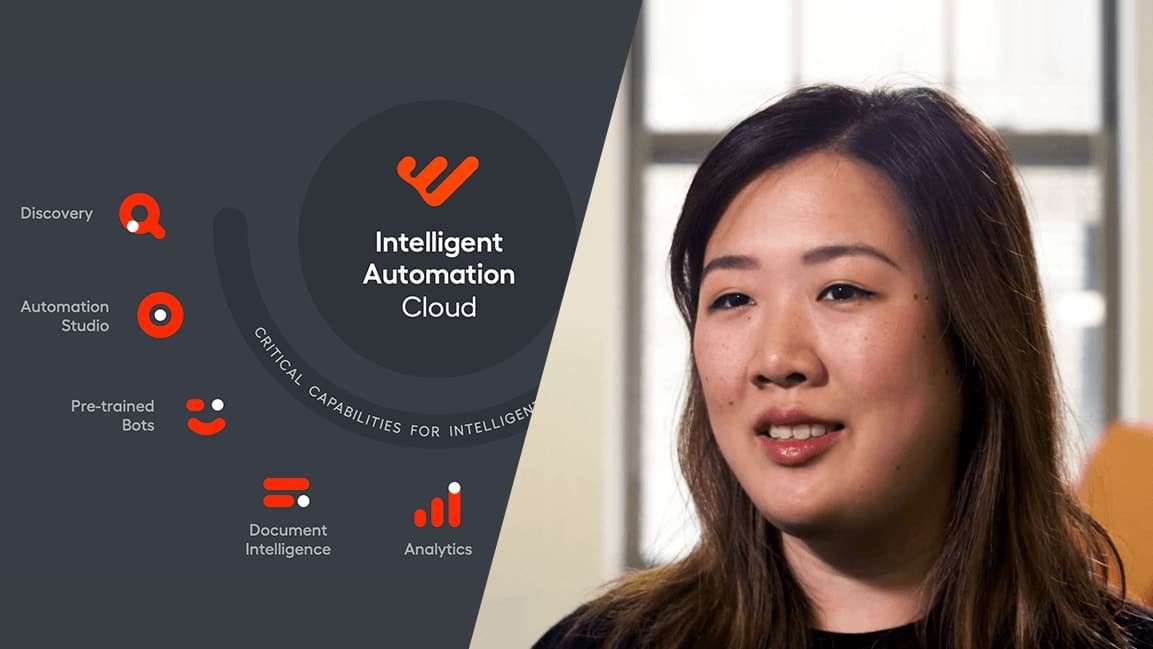On May 12, WorkFusion hosted the first online event dedicated to Hyper Automation: Virtual Summit 2020. Industry experts, strategists and visionaries, plus members of the WorkFusion team, discussed timely topics and shared insights on the future of Intelligent Automation — including how the current pandemic will affect digital transformation programs.
If you weren’t able to participate live, you can now watch on-demand. Here are some recaps to point you in the direction of what you’ll find most useful.
Topics fall into two primary categories:
- Customer success and practical advice from innovation leaders
- Automation and digital transformation guidance and industry analysis
Customers talk about implementing Intelligent Automation
Change management is vital for digital transformation
Effective change management and communication are key for automation. As Julie Dillman (Chubb Group) says, this was one of the most critical lessons from that company’s digital transformation experience.
She particularly emphasizes the need for up-skilling employees:


Re-skilling the talent, to have the data- and process-management skills they need to manage the processes going forward is something that we are working very diligently on, toward making sure our workforce is prepared for the future.


Account opening processes have unmatched automation potential
Account opening operations are at the heart of customer experiences in any bank. Benefits of account opening automation include:
- Improving customer experience and turnaround times
- Increasing capacity, thus creating more opportunities to grow in the market
- Decreasing the number of manual errors in this highly regulated business
- Enhancing due diligence and regulatory compliance
In his presentation, Michael Daniels (Standard Bank) talks about why Standard Bank started its automation journey with Account Opening, what elements they have streamlined, and the benefits they realized with Intelligent Automation.
Watch Michael Daniels’s presentation and see how Standard Bank automates Account Opening and KYC→
Basic RPA is not a long-term solution for automation success at scale
When starting to explore automation, many banks tend to implement basic RPA, try to remove people from the processes altogether, and focus on integrating applications in the automated process.

During the Enterprise Scaling Roundtable with Veronika Andreeva, Nischal Piratla (Deutsche Bank) and Matt Speare (Carter Bank & Trust), agree that it is not a long-term solution for automation success.
Many banking processes have issues that cannot be solved by mere RPA, such as variability of regulatory requirements in various locations and heavy reliance on paper documents in the processes. The processes need to be streamlined. So, other Hyper Automation capabilities such as ML, OCR and analytics will be crucial for long-term automation success.
AML is a great starting point for automation

In the Financial Crimes Roundtable with Grant Vickers, Sehr Saghir (Bank of Montreal) and Ivan Zasarsky (PwC Canada) discussed the reasons why AML is a great starting point for your Intelligent Automation program.
Identifying the best first process for automation is an essential factor in automation success.
They single out several strong reasons:
- Eliminating the extensive manual work ensures that automation will have a sizeable impact.
- AML processes are standard across various business lines in banks, so automation solutions are re-usable and easily scaled.
- Customers are directly affected by these processes, so there is a tremendous opportunity to improve their experiences.
- Intelligent Automation can reduce the costs of AML programs and improve their effectiveness.
Watch Financial Crimes Roundtable for more valuable insights on AML automation→
Industry thought leaders look at the big picture
Digital transformation is unavoidable
The events of the past months have been very disruptive and have shown us that digital transformation cannot be avoided. E-commerce or online education have been actively developing for years. But these past few months have given them new momentum, as traditional retailers and schools were forced to dramatically change their business models to accommodate the new reality brought by the COVID-19 pandemic.
Even technology leaders had to speed up their transformation programs to keep up. According to Satya Nadella, Microsoft has “seen two years’ worth of digital transformation in two months.”
All industries had to transform, and those who reacted the fastest won. As Alex Lyashok said in his welcome speech:


Disruption causes the most damage when it is met with resistance.


Watch Alex Lyashok’s session “CEO Address: The State of Intelligent Automation”→
The pandemic will accelerate adoption of Intelligent Automation

In his presentation, “The Future of Work: A Pandemic Response for Enterprise Automation”, Forrester analyst Craig Le Clair predicts that after a pause, businesses will see 12–24 months of accelerated adoption of artificial intelligence and digital transformation, as well as ramped-up investment in those areas.
The focus will shift from merely integrating and connecting applications toward Intelligent Automation technologies such as machine learning, conversational intelligence, and text analytics, as well as collaboration between automation and people, or the Human in The Loop capability.
Watch Craig Le Clair’s presentation on demand→
‘Going back’ is not the same as ‘coming back’

There are several recovery trajectories that businesses might follow after the crisis, including V-, U-, L- and Y-shaped recovery models. Geoffrey Moore — author, advisor, and member of WorkFusion’s Board of Directors — discusses the differences in his keynote address. He gives particular attention to two variations of the Y-shaped model: “going back” and “coming back” — which sound similar but differ considerably.
“Going back” would be returning to the “old normal”, or restarting your supply chain and go-to-market engines, perhaps re-engineering your processes to be more efficient and cost-effective. “Coming back“, on the other hand, is creating a “new normal” and disrupting existing operations. This recovery model provides opportunities for digital transformation due to more newly acquired freedom and less resistance to change.
Watch Geoffrey Moores’ keynote address “Driving Innovation Keynote: Restart Your Engines!”→
Hyper Automation is driving agility in banks
The companies that seem to be most successful in adapting to the current situation are the ones that invest heavily in risk management and agility. Many are in the financial sector.
Dr. Homaira Akbari (AKnowledge Partners) states during her presentation:


Hyper Automation and Artificial Intelligence technologies drive banks’ agility, allowing them to react to changes faster.


One example is Scotiabank, which uses WorkFusion’s pre-built solution for anti-money laundering. This is especially topical now, as financial crimes are on the rise and banks need to focus more strongly on cybersecurity and fighting malfeasance.
Watch Homaira Akbari’s presentation in full→
Companies will need fewer, but more secure, hyper automation tools
After the current crisis, automation budgets will likely be under a lot of pressure. Organizations will have to show returns fast and will be more conscientious about spending. As a result, it will be essential to pick Hyper Automation platforms for the entire business, not just for pockets of the business.
Moreover, companies will pay more attention to the level of data security that the automation platform will be able to provide. As Sameer Jain stated in his conversation with Brian Briggs:

Data privacy, data leakage and cybersecurity will really need to be baked into the solutions, right from the get-go.

Get more valuable advice from Sameer Jain→
The most successful companies disrupt themselves
According to Martec’s Law, technology changes exponentially, or fast, while organizations change logarithmically, or slow. As a result, the change gap widens over time — so the longer you wait to “disrupt yourself“, the harder it is to do.
To stay successful, your organization needs to embrace iterative changes. Tony Saldanha thinks that it is instrumental if you want to be successful in your digital transformation journey.

You have to have not only yourself [IT or shared services organization] embrace technology, but you have to have your entire company embrace technology.

Watch Tony Saldana’s speech on how to succeed in digital transformation→
We hope you found these takeaways helpful for you and your company’s digital transformation strategy. If you would like to learn more about WorkFusion’s Intelligent Automation solutions for banking, insurance and other industries, feel free to contact us.





























